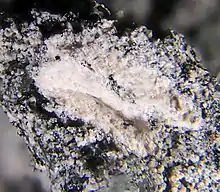| Combeite | |
|---|---|
 Pale pink crystal aggregates of the very rare silicate mineral combeite from one of the only 4 localities known worldwide: Mount Oldoinyo Lengai, Arusha Region, Tanzania. | |
| General | |
| Category | Silicate mineral |
| Formula (repeating unit) | Na2Ca2Si3O9 |
| IMA symbol | Cbe[1] |
| Strunz classification | 9.CJ.15a |
| Crystal system | Trigonal |
| Crystal class | Trapezohedral (32) (same H-M symbol) |
| Space group | P3121 |
| Unit cell | a = 10.42 Å, c = 13.14 Å; Z = 6 |
| Identification | |
| Color | Colorless |
| Crystal habit | Stout prisms |
| Streak | White |
| Diaphaneity | Transparent |
| Specific gravity | 2.844 |
| Optical properties | Uniaxial (+) |
| Refractive index | nω = 1.598 nε = 1.598 |
| Birefringence | δ = 0.000 |
| References | [2][3][4] |
Combeite is a rare silicate mineral with the formula Na2Ca2Si3O9. It has a trigonal crystal system.
Discovery and occurrence
It was first described in 1957 for an occurrence in nephelinite lavas and tephra on Mount Nyiragongo, Goma, Kivu, Democratic Republic of Congo (then Zaïre).[3] It has also been reported from the Bellerberg volcano in Ettringen, Germany and the Oldoinyo Lengai volcano, Tanzania.[3] It was named for Arthur Delmar Combe of the Geological Survey of Uganda.[4][5]
It is associated with götzenite at Mount Shaheru, Congo; and with wollastonite, clinopyroxene, nepheline, melilite, titanian garnet and titanian magnetite at Oldoinyo Lengai.[5]
References
- ↑ Warr, L.N. (2021). "IMA–CNMNC approved mineral symbols". Mineralogical Magazine. 85 (3): 291–320. Bibcode:2021MinM...85..291W. doi:10.1180/mgm.2021.43. S2CID 235729616.
- ↑ Mineralienatlas
- 1 2 3 Combeite on Mindat.org
- 1 2 Combeite data from Webmineral
- 1 2 Handbook of Mineralogy
This article is issued from Wikipedia. The text is licensed under Creative Commons - Attribution - Sharealike. Additional terms may apply for the media files.